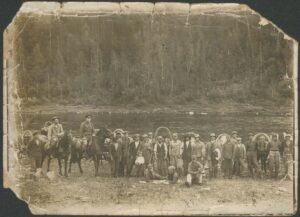Among the people visible in the picture of the deportees there is Jan Witusiak (fourth from the left in the second row, with the net rolled above his head – the net was used to protect a worker from flies). Witusiak family was deported on 10 February 1940.The family consisted of Jan and Józefa with children: Władysława, Mieczysław, Wanda, Kazimierz, Tadeusz, Albina and Franciszek. The family was sent to the Teya poselok, in Krasnoyarsk Krai. Jan was working in floating the wood. Who are the deportees working with him? We know that Rodycjusz Gerlach and him family were also deported to Teya poselok from the Mazury village near Pidhajtsi in Stanisławów Voivodeship . As he recollected, two barracks, in which around 80 deported families were living, were called Pidhajtsi and Berezhany due to their places of origins. Is someone of them also of this photograph? The locals named this place in their own manner: Zimoviateya . All of them were working in cutting down trees. The wood was used to fuel up the power station, which was operating the nearby gold mines.
From the open-access information on the Internet it is known that in 1946 mechanical workshops started to built. They were used to operate the river dredges. By the end of the 1940s, with the help of the delegated workers of “Norylskstroy”, two energetic blocks were built, with the power of 1000 kilowatts.




